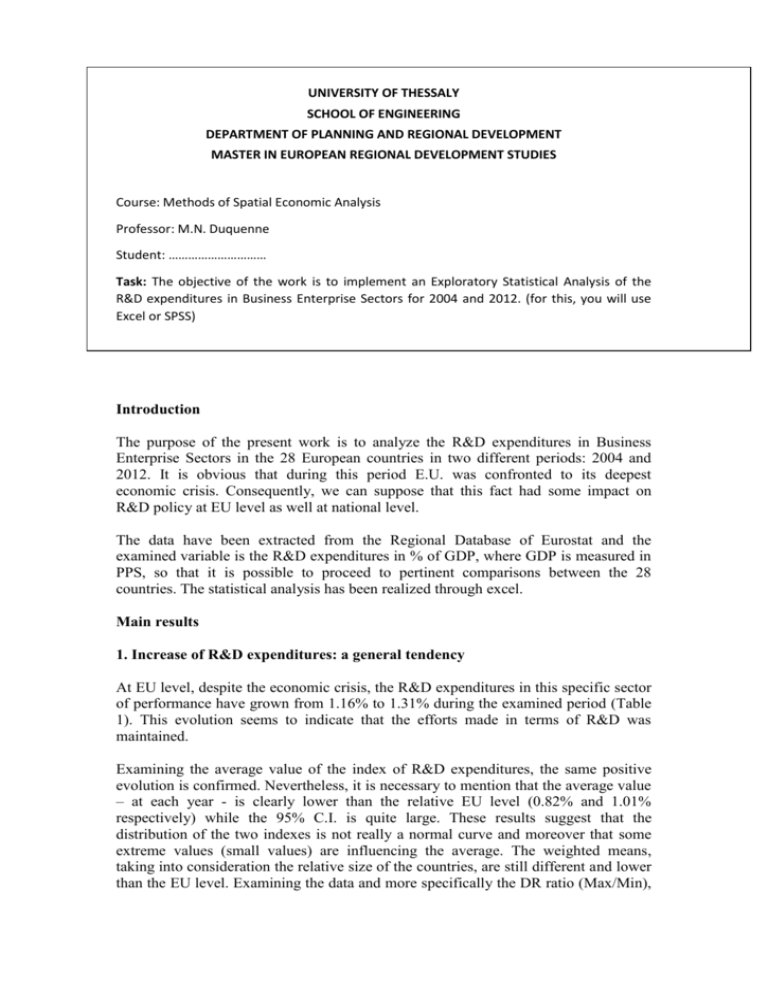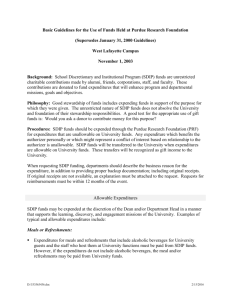UNIVERSITY OF THESSALY SCHOOL OF ENGINEERING
advertisement

UNIVERSITY OF THESSALY SCHOOL OF ENGINEERING DEPARTMENT OF PLANNING AND REGIONAL DEVELOPMENT MASTER IN EUROPEAN REGIONAL DEVELOPMENT STUDIES Course: Methods of Spatial Economic Analysis Professor: M.N. Duquenne Student: ………………………… Task: The objective of the work is to implement an Exploratory Statistical Analysis of the R&D expenditures in Business Enterprise Sectors for 2004 and 2012. (for this, you will use Excel or SPSS) Introduction The purpose of the present work is to analyze the R&D expenditures in Business Enterprise Sectors in the 28 European countries in two different periods: 2004 and 2012. It is obvious that during this period E.U. was confronted to its deepest economic crisis. Consequently, we can suppose that this fact had some impact on R&D policy at EU level as well at national level. The data have been extracted from the Regional Database of Eurostat and the examined variable is the R&D expenditures in % of GDP, where GDP is measured in PPS, so that it is possible to proceed to pertinent comparisons between the 28 countries. The statistical analysis has been realized through excel. Main results 1. Increase of R&D expenditures: a general tendency At EU level, despite the economic crisis, the R&D expenditures in this specific sector of performance have grown from 1.16% to 1.31% during the examined period (Table 1). This evolution seems to indicate that the efforts made in terms of R&D was maintained. Examining the average value of the index of R&D expenditures, the same positive evolution is confirmed. Nevertheless, it is necessary to mention that the average value – at each year - is clearly lower than the relative EU level (0.82% and 1.01% respectively) while the 95% C.I. is quite large. These results suggest that the distribution of the two indexes is not really a normal curve and moreover that some extreme values (small values) are influencing the average. The weighted means, taking into consideration the relative size of the countries, are still different and lower than the EU level. Examining the data and more specifically the DR ratio (Max/Min), it is clear that at least one country (Cyprus) is very far from the leader country (Sweden in 2004 and Finland in 2012). Table 1: Parameters of Central tendency, 2004 and 2012 EU-28 level Mean value (arithmetic) Weighted mean Lower Born 95% Confidence Interval Upper Born Minimum Maximum DR RATIO Std. Deviation Simple CV coefficient Weighted 2004 1,16 0,82 0,96 0,552 1,078 0,080 2,630 33 0,711 87% 78% 2012 1,31 1,01 1,12 0,742 1,281 0,060 2,440 41 0,728 72% 63% Moreover, even if the median also increased during the period (from 0.55% to 0.93%), it is obvious than 50% of the countries are still far from the EU level. Nevertheless, the fact that the median increased allows us to accept that generally this positive evolution concerns not only the most developed countries but most of the 28 European countries. This can be easily confirmed by calculating the rate of growth of R&D expenditures between 2004 and 2012 (Table 2). Only 5 countries have a negative rate while some others are characterized by very positive rate (with an increase more than twice). rate 100 * R & D2012 R & D2004 R & D2004 Table 2: R&D expenditures’ rate of growth Country RD_BUS04 RD_BUS12 1,28 0,12 0,75 1,69 1,75 0,33 0,81 0,17 0,58 1,36 0,44 0,52 0,08 0,19 0,16 1,43 0,36 0,34 1,03 1,52 0,16 0,27 0,21 0,93 0,25 2,42 2,63 1,04 1,52 0,39 1,01 1,96 2,02 1,25 1,20 0,24 0,69 1,48 0,34 0,69 0,06 0,15 0,24 1,00 0,85 0,50 1,22 1,95 0,33 0,70 0,19 2,16 0,34 2,44 2,31 1,09 Belgium Bulgaria Czech Republic Denmark Germany Estonia Ireland Greece Spain France Croatia Italy Cyprus Latvia Lithuania Luxembourg Hungary Malta Netherlands Austria Poland Portugal Romania Slovenia Slovakia Finland Sweden United Kingdom Rate of Growth (%) 2004-2012 18,8 225,0 34,7 16,0 15,4 278,8 48,1 41,2 19,0 8,8 -22,7 32,7 -25,0 -21,1 50,0 -30,1 136,1 47,1 18,4 28,3 106,3 159,3 -9,5 132,3 36,0 0,8 -12,2 4,8 Source: Eurostat, Own treatment 2. Regional inequalities: convergence or divergence? The main questions emerging from the above analysis are the following: (a) Can we consider that in terms of R&D expenditures, the EU present deep regional inequalities? (b) Can we observe a relative reduction of regional inequalities between 2004 and 2012? The responses to these two questions can be find through the examination of the various parameters of variation as for example the standard deviation and more over the coefficients of variation (simple one and weighted one). The variation of the standard deviation (0,711 to 0,728) is quite limited if we take into consideration that the average value of the variable has increased from 0.82% to 1.01%. Consequently, the coefficient of Variation CV slowly declined from 87% to 72%. If we can accept a relative tendency to convergence, the inequalities are still important and this main result is absolutely confirmed by the weighted CV who is also declining but remains quite high (78% to 63%). Obviously, countries with the highest rate of growth (Table 2) are generally countries with very small level of R&D expenditures in 2004 as for example Bulgaria, Estonia, Hungary, Poland or Portugal, while the most developed countries as for example Germany, France or Finland are characterized by a limited growth and Sweden presenting a negative rate. In conclusion, the development of R&D in the Business Enterprise Sectors during 2004 to 2012 was confirmed despite the economic crisis even if at EU-level, the rate of growth is quite limited (about 13%). The diachronic evolution differs deeply from one country to the other so that we can admit that there is a relative trend of convergence with countries in less favorable situation in 2004, making the highest effort. Despite this positive aspect, the regional inequalities are still important with a w_CV more than 60%.










